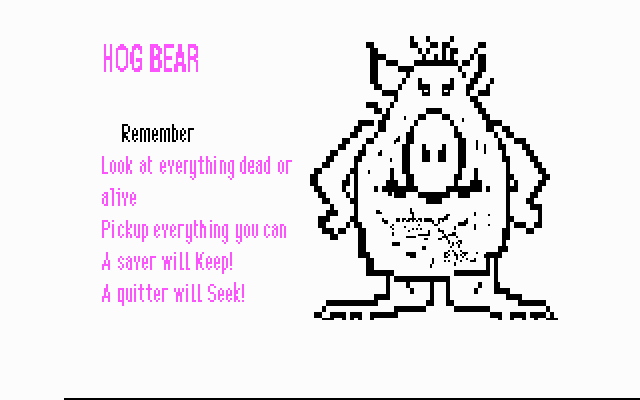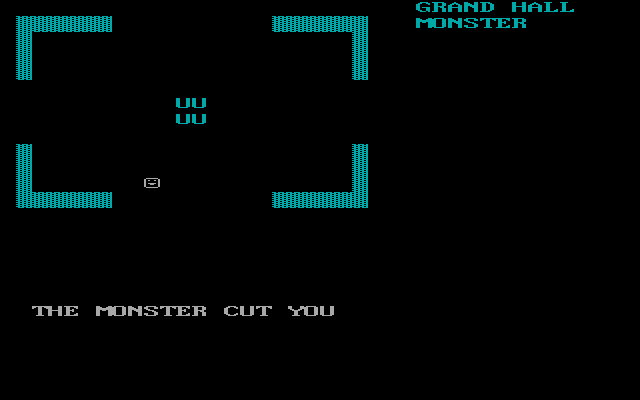Retro Replay Review
Gameplay
Hogbear plunges you into a sprawling, shadowy mansion where every corridor could be your last. You’ll navigate through interconnected rooms, each populated by creatures ranging from a brooding vampire to a lumbering ogre. Exploration is key: you must search for useful items, uncover secret passages, and collect a variety of weapons to stand a chance against the castle’s horrors.
Though Hogbear markets itself as a graphical update of Castle Adventure, it retains a significant text-input component for interactions. Moving around the estate uses the cursor keys, allowing you to traverse rooms with familiar controls, but picking up objects or engaging in dialogue still requires typed commands. This hybrid system blends the immediacy of action with the depth of classic text adventures.
Combat in Hogbear is deceptively simple yet strategically rich. To attack a monster, you move into it while wielding a chosen weapon—anything from a razor-sharp blade to the game’s cheeky “dead chicken” option. Your choice of arms and your positioning in each cramped chamber can mean the difference between life and a gruesome demise at the claws of Hogbear itself. This early example of “survival horror” emphasizes resource management and spatial awareness over twitch reflexes.
Graphics
Visually, Hogbear marries ASCII art with splashes of color to evoke a foreboding atmosphere. Walls, doors, and monsters are rendered in simple characters, but the judicious use of red for bloodstains or green for poisonous slimes adds a vivid flair that sets it apart from pure text adventures. It’s a nostalgic aesthetic that taps into the retro roots of ASCII gaming.
While the game boasts an updated look compared to its predecessor, these graphical enhancements are relatively modest. You won’t find fully animated sprites or elaborate backdrops—rather, Hogbear leans into the charm of minimalism. Each room feels claustrophobic yet distinct, and the absence of high-resolution art actually heightens your imagination, making every corner feel unpredictable.
The interface strikes a balance between text and graphics: descriptive passages supplement the colored ASCII, providing context and atmosphere. Whether you’re facing down a vampiric sentinel or stumbling upon a secret cache of ammunition, the blend of words and symbols ensures that you’re never left guessing what kind of danger lurks ahead.
Story
At the heart of Hogbear lies its sinister host, the eponymous beast who mocks you through taunting narrations scattered throughout the estate. The mansion’s halls are rife with cryptic notes and whispered threats, each reinforcing the idea that Hogbear is both omnipresent and unpredictable. You’re not merely fighting monsters—you’re trying to outwit a cunning mastermind.
The tone is darkly humorous, channeling a wicked grin that undercuts genuine terror with sarcastic jabs. The narrative voice often breaks the fourth wall, as if Hogbear himself is addressing you directly, daring you to survive another room. This approach infuses the gameplay with personality, making every encounter feel like part of a larger, malevolent performance.
Your journey unfolds in layers: you start by scavenging basic tools and uncovering the mansion’s layout, then gradually piece together the lore of previous victims and the castle’s grim history. By the time you confront the vampire guardian or the final showdown with Hogbear, the stakes feel personal, fueled by the dark humor and ominous hints that permeate every corridor.
Overall Experience
Hogbear delivers a uniquely unsettling adventure that balances retro charm with genuine suspense. Its hybrid interface may feel antiquated to modern players accustomed to point-and-click or fully graphical titles, but those willing to embrace the blend of text and ASCII art will discover a richly atmospheric world full of surprises.
Fans of classic adventure games and early survival horror will appreciate the deliberate pacing and room-by-room tension. Navigating the mansion demands patience and a keen eye, while the need to type in commands for critical interactions adds a layer of immersion that few contemporary titles replicate. This straightforward yet punishing design ensures that each triumph—whether besting an ogre or unearthing a hidden key—feels hard-won.
Ultimately, Hogbear stands as a testament to the ingenuity of early adventure designers: a game that feels both nostalgic and fresh. Its humor, combined with an oppressive atmosphere and strategic combat, makes for a memorable journey. If you’re seeking a retro-inspired challenge that tests your wits as much as your reflexes, this dark mansion has plenty of secrets and terrors waiting for you.
 Retro Replay Retro Replay gaming reviews, news, emulation, geek stuff and more!
Retro Replay Retro Replay gaming reviews, news, emulation, geek stuff and more!








Reviews
There are no reviews yet.